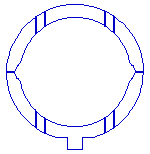The MGA With An Attitude
BEARING MATERIALS And TOLERANCES -- CS-211

 You may notice on the prior page that there are three different BMC part numbers for MGA (and MGB) connecting rod bearings, and at least five different trade names with ten different manufacturer part numbers, and that all of these parts are physically interchangeable. Of course we understand multiple sources, but what's the deal with multiple part numbers from one source, and multiple BMC part numbers? The deal is, not all bearings are equal, and maybe you would like to know the difference before you make a choice.
You may notice on the prior page that there are three different BMC part numbers for MGA (and MGB) connecting rod bearings, and at least five different trade names with ten different manufacturer part numbers, and that all of these parts are physically interchangeable. Of course we understand multiple sources, but what's the deal with multiple part numbers from one source, and multiple BMC part numbers? The deal is, not all bearings are equal, and maybe you would like to know the difference before you make a choice.
As to the specifics, there are tri-metal bearings (steel, copper and white metal) vs. bi-metal bearings (steel and white metal), there are lead-indium bearings (hard white metal) vs. lead-tin bearings (soft white metal), and there are different levels of precision and running clearance available. For a daily driver used for casual touring, and not expecting to rack up too many miles in the next 10 or 20 years, maybe any of these bearings will work as well, and you can buy whatever is cheap. For a competition engine or long life you may prefer lead-indium over lead tin. For either competition or a hard running engine doing lots of miles, better precision with closer control of oil film thickness may be preferred. This is why the factory had three different part numbers, different specifications for different service expectations. Now which is which, and are they still the same today as they were 50 years earlier (good, better or worse)?
Here is an example. Apparently some time ago Vandervell bought up Glacier. Vandervell have been noted for good quality bearings, tri-metal topped with lead-indium, and a couple different precision specifications available (VP2 or VP3). Glacier bearings may be bi-metal and are most likely lead-tin overlay (and maybe lower precision). If you know the difference you can make an informed decision. But now there are packages that say Vandervell-Glacier on the side, and have Glacier bearings inside. These are sometimes advertised as Vandervell bearings with no mention of the specifications, which is definitely misleading.
For original MGA 1500 bearings, the Workshop Manual calls the main bearings Steel Backed White Metal, which would (probably) be lead-tin bearings. Main bearing running clearance was specified as .0005-.002. Connecting rod bearings were called Steel Backed lead-indium or lead-tin, could be either white metal alloy. Rod bearing running clearance was spec'd as .0001-.0016, but one tenth of a thou is definitely not going to work for oil flow. There may have been some trick to this in production, like hand selected parts to assure greater minimal clearance.
It is worth mention the con-rod bearing side clearance is spec'd as .008-.012 (.004-.006 on each side). This is nominally .010 +/-.002, which is a common specification for side clearance in many engines. The side clearance is important because it provides for machining and positional tolerance of the crankshaft and cylinder bores.
For the 1600 engine rod bearing running clearance spec was changed to .0010-.0025. This is more "real", allowing .001 minimal clearance for oil flow to cool the bearings for good cooling. With no change of crankshaft specifications, this would mean the rod bearing shells were slightly larger bore and slightly closer size tolerance. It appears the change of part number actually occurred fairly early during 1500 production at engine no. 6330, which would be June 1956.
For the 1622 engine the main bearing running clearance spec changed to .001-.0027, finally showing .001 minimum clearance for oil flow. Con-rod bearings were not changed.
For the Twin Cam engine the main bearing AND connecting rod bearing running clearance is .002-.0037. Notice the increase for minimum clearance at .002 which will provide more oil flow for better bearing cooling of the higher revving engine. This is covered by different part numbers for the bearings in the Twin Cam engine.
|